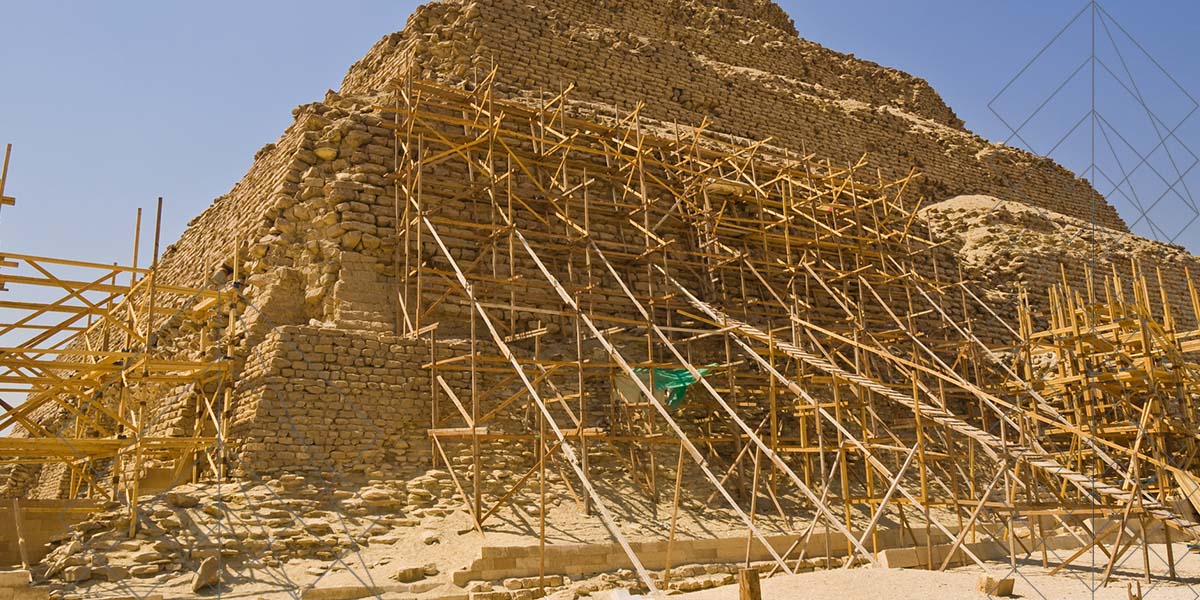Many tools and products we use today were originally invented by ancient civilizations like the Egyptians, Mesopotamians and Mayans. This includes scaffolding, though modern scaffold has come a long way to get to where it is now.
This guide walks you through everything you ever wanted to know about scaffold, from its ancient origins to its modern design and usage.
When Was Scaffolding Invented?
Although historians are unable to pinpoint the invention of scaffold to a specific year, archaeologists suspect that it dates all the way back to prehistoric times.
Proponents of this theory point to the 17,500-year-old paintings in the French Lascaux Caves as evidence. These paintings are so high up in the cave that their creators would have had to use a support structure to reach them, and a series of indentations found near the paintings seem to indicate the presence of something like scaffold.
Who Came up With Scaffolding?
Because so many early societies were using some type of scaffold at the same time, it’s impossible to determine who the original inventor may have been. That said, historians generally agree that Daniel Palmer-Jones and his brother, David Henry Jones, were the minds behind modern scaffold design.
Palmer-Jones patented the “scaffixer” in 1910 as a way to connect scaffold components and fix them in place. While this patent expired in 1928, it had significant ramifications for the entire industry.
How Did Scaffolding Evolve Over Time?
It took a long time for scaffold designs to look like what we use today. Here’s a quick overview of how it changed from ancient times to now.
Ancient Scaffolding
Ancient scaffold was usually simple in design and made from pieces of wood or bamboo tied together with rope.
Historians know the ancient Egyptians would have had to use basic wooden scaffold to build their massive pyramids, though most of their construction methods remain a mystery to this day. Recent restoration professionals have used similar structures to perform work on the Pyramid of Giza, which provides further evidence for this theory.
In ancient China, scaffolders constructed elaborate structures from bamboo with little to no safety gear available. It’s still widely used in Hong Kong due to its flexibility and cost-effectiveness, though worker safety has become a much larger concern.
Medieval Scaffold
To build the soaring Gothic cathedrals and castles of the High Middle Ages, workers first needed to reach the heights of their designs. Scaffolding was essential for this task, and lingering “put-log” holes on these structures show where they stood.
Early Modern Scaffold
Scaffold was just as necessary during the European Renaissance when new methods of architecture and art were emerging one after the other.
Consider Michelangelo’s frescos on the ceiling of the Sistine Chapel — and his portrayal of the Last Judgment on the chapel’s wall. These massive paintings would not have been possible without some kind of structural support.
Throughout the rest of the early modern period and well into the Victorian era, scaffolding continued to evolve.
Scaffolding Today
From ancient Chinese to Egyptian scaffolding, the original scaffold structures were relatively similar to the ones we use today. However, there are a few key differences in the required materials and designs to be aware of:
- Materials: Where previous generations used wood or bamboo, today’s scaffold professionals use tubular steel frames for their robust composition and ability to hold significantly more weight.
- Safety: Safety requirements have evolved significantly, even over the past few decades. Modern personal protective equipment (PPE) like hard hats and visibility gear is another relatively recent invention, dating back to the early 20th century.
- Innovation: “Smart” scaffolding is an emerging technology that uses advanced 3D modeling software to enhance traditional scaffold design and installation. With the rise of artificial intelligence (AI) across various industries, we’re likely to see more development in this area.
Types of Modern Scaffold
Today’s scaffold systems have several different variations that are advantageous for use in specific applications:
- Single scaffold: This basic type uses ground-rooted standards that are parallel to the building’s walls.
- Double scaffold: A double scaffold is more secure than a single scaffold because the perpendicular row of the scaffold reinforces the first parallel row.
- Cantilever scaffold: This type uses a series of supports, or needles, that are directly inserted into the wall to provide support in areas where workers have limited access to the ground.
- Baker scaffold: This type consists of a platform with a ladder on each side for easy access and mobility.
- Suspended scaffold: This lightweight type attaches to a building’s roof with wires and hangs over the side of the building for easy access to the facade.
Why Is It Called Baker Scaffold?
While one common assumption is that Baker scaffold was named after its inventor, no authoritative evidence exists to back up that claim.
Also known as narrow frame or rolling scaffold, Baker scaffold is a wheeled modular platform intended to move easily between work areas. It’s most commonly used in the construction and building renovation industries for applications such as painting and drywall installation.
How Scaffolding Safety Has Evolved
Prior to the 20th century, there were no substantial safety precautions required when navigating a scaffold system.
Modern regulations from the Occupational Safety and Health Administration (OSHA) state that employees should receive proper training before using any type of scaffold. This training must teach the trainee key principles of safe operation, including:
- Determining maximum load limits before handling materials on the scaffold
- Knowing where to stand on the scaffold to mitigate risk
- Performing preventive maintenance on scaffold
- Recognizing scaffolding hazards such as falls, electric shock, and falling objects
- Waiting to move Baker scaffolds until all workers on the platform are made aware of the move
Rental scaffold is a modern convenience that owners and builders can take advantage of to enhance their on-site scaffolding safety. Often, working with a scaffold provider that prioritizes safety in its operations can help your company ensure you’re meeting all federal OSHA and Cal/OSHA regulations throughout your project.
Get the Best of History With Champion Scaffold Services Inc.
Scaffolding professionals throughout the ages have changed their designs to reflect the emerging technological knowledge of each era. Since 2009, the experts at Champion Scaffold Services have leaned on that knowledge to continually improve our service offerings, from installation to dismantling.
We are a full-service scaffold company serving contractors and subcontractors across the Greater Bay Area, Southern California and Nevada. Whether your project is in the industrial, commercial or residential sector, Champion Scaffold Services will provide the support you need to get the job done safely.
Get personalized rental scaffold service that’s compliant with federal OSHA and Cal/OSHA regulations. Contact us today for more information about our scaffold services.



